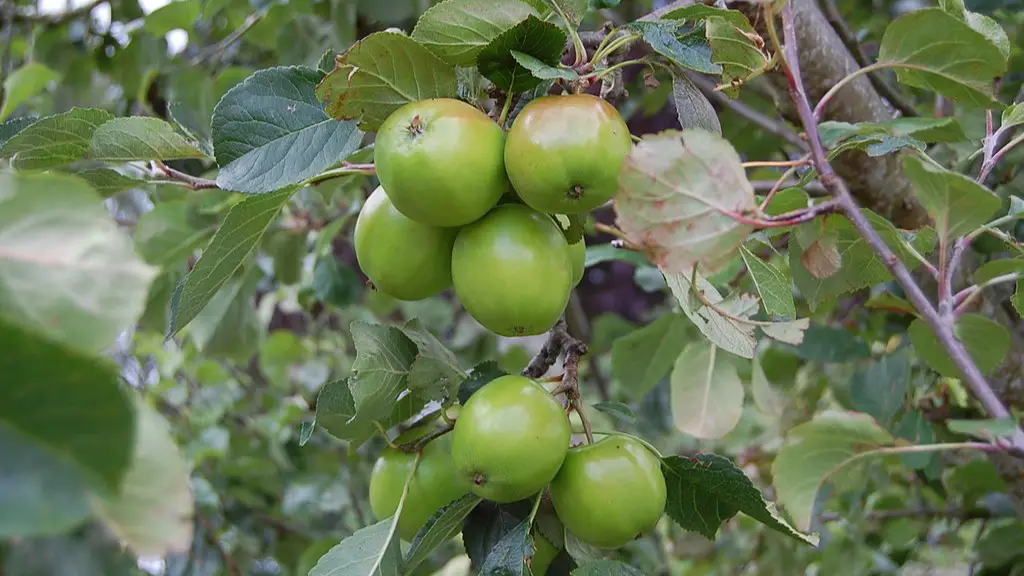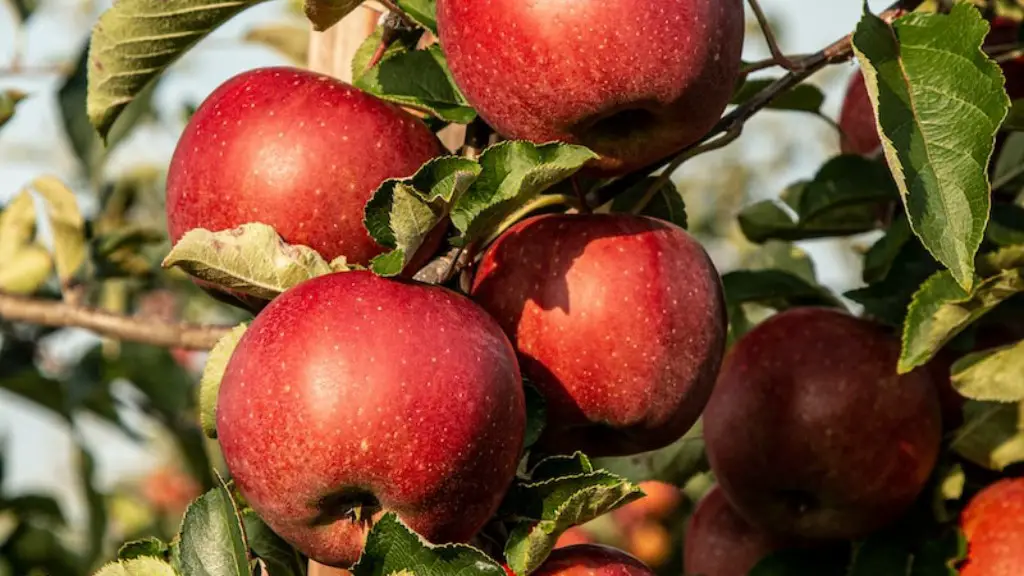Apple tree flowers blossom in the spring and are a sign of nature’s renewal. Every year, growers and gardeners alike anticipate this annual event. Most of us understand that apples come from apple trees, but what really happens during the growing season that results in the harvest? Do apple tree flowers turn into fruit?
The short answer to this question is yes, the flowers of a tree eventually change into fruit and provide us with the apples we know and love. For the flower to become an apple, the tree needs more than just a sunny, summer day – it requires pollination for the flower to transform into an apple.
Pollination is a process, specifically a type of biological cross-pollination, where external organisms such as bees and other species are needed to transfer pollen from one plant to another. This is necessary for fertilization to occur, and therefore vital for the successful growth of the apple tree. Without pollination, there would be no fertilized apple tree flower, and thus, no fruit.
The structure of the apple tree flower is essential in understanding how a flower can change into an apple. All apple tree varieties are composed of five petals and five sepals, plus a host of other mechanisms. At the centre of the flower is a tuft of stamens which is the male part of the flower, and below these are the nectaries that contain the nectar and are part of the female reproductive system.
When the appropriate conditions are met, pollinators such as bees enter the flowers and pick up the pollen. They then carry this pollen to the other flowers, completing the process of pollination. Pollination is necessary for fertilization as it results in the production of viable seeds inside the ovaries, which in turn, results in apples. The resulting apples are your typical shop-bought variety, or local, seasonal delicacies.
It’s worth noting that while pollination is the key factor in apple tree flowers transforming into fruit, climate can also have an effect. An ideal number of days with temperatures between forty-five and sixty-five degrees Fahrenheit is necessary for the apple tree to blossom, as is an ideal amount of rain.
Overall, apple tree flowers turn into fruit due to the need for pollination, which allows for the production of viable seeds and finally, apples. This process is highly dependent on a variety of factors and shows how nature works in harmony to create a bountiful harvest for us to enjoy.
The Role Of Bees in Apple Tree Flower Transformation
One fundamental part of this process of apple tree flower transformation is the role of bees. Bees are the essential pollinators responsible for carrying pollen between apple trees. When bees fly from flower to flower, they pick up pollen on their legs and disperse it elsewhere. This pollen is what allows fertilization of the flowers, which leads to the development of apples. Bees need the nectar they collect to give them energy, and in turn, they provide us with apples. It is a true collaboration between humans and nature.
The bee’s diet also has a bearing on the health of the apple tree. It has been shown that if bees are exposed to too much of certain types of pesticide, their effectiveness at pollinating apples is diminished. The role of bees in the production of apples is of great importance, and it is something we must consider when managing apple tree cultivation.
Beekeepers across the world have taken to creating special hives for the indigenous bees that inhabit their area. These beekeepers are conscious of the importance of bees for their nearby apple trees, whether for domestic production or for commercial ones.
Beekeepers also use special methods to help the bees find the flowers of their apple trees. They make use of coloured plates to attract the bees so that they can be steered in the right direction. By doing so, they are helping the process of pollination and thus, of turning the flower into a fruit.
In conclusion, bees are essential in the transformation of apple tree flowers into apples. Beekeepers should ensure they provide their bees with the proper environment; this is in order to guarantee a successful apple tree flower transformation.
The Role Of Climate In Apple Tree Flower Transformation
The climate also plays a major role in the transformation of apple tree flowers into fruits. As previously stated, the optimum climate for this transformation is temperatures between forty-five and sixty-five degrees Fahrenheit and a proper quantity of rain.
It has been demonstrated that if the temperature is too high or too low, pollination does not take place and so a high-quality apple cannot be produced. On the other hand, if the climate is too dry, pollination is also interrupted, resulting in the same consequence. For example, if the temperature during the blossom period is too low or too high, or if there is a lack of rain, the flower will follow its natural cycle and dry, without turning into fruit.
Variations in the climate due to global warming are also making the transformation of flower to fruit increasingly difficult. In some regions, there is not enough rain to sustain the apple trees, or the right amount and temperature to allow for adequate pollination.
Farmers and gardeners are attempting to work around these climate issues. Different methods such as using greenhouse structures and artificial rain, have been implemented in order to improve the chances of a successful transformation from flower to apple. These initiatives have been partially successful, and have allowed some farmers to increase their apple harvest.
Ultimately, the climate is a major factor in determining whether apple tree flowers will turn into fruit. Farmers and gardeners must take into account the effects of global warming and take appropriate steps in order to guarantee a successful transformation of apple tree flowers into apples.
The Role of Soil in Apple Tree Flower Transformation
In addition to pollination and climate, the soil in which apple trees are planted also affects the process of flower to fruit transformation. Different variations of soil are necessary for a successful harvest.
First of all, the soil needs to have good drainage to guarantee that the apple tree does not rot and the apple tree flower is less likely to suffer from watering issues. The soil should also contain enough Organic Matter to facilitate the nutrients that the apple tree requires for its growth. If the soil’s pH level is not suitable for the types of apples that are being grown, it is likely that the apple tree flower will not bloom properly.
Furthermore, the soil should offer enough nutrients to ensure that the flower has the necessary building blocks required for the apple to turn out to be the right size and colour; this is essential in the apple tree flower transformation. If there is not enough nitrate and other minerals, the apples won’t reach their full potential.
The soil’s quality is also very important in regard to providing protection against pests and diseases. An unsuitable quality soil will leave the apple tree vulnerable to a wide range of threats, which will affect the apple tree flower transformation process.
All in all, the soil is the foundation for the successful transformation of apple tree flowers into fruit. Gardeners and farmers should take into consideration its physical and chemical components in order to guarantee a healthy and productive apple tree.
The Role of Fungicides in Apple Tree Flower Transformation
Another factor that can determine whether apple tree flowers transform into fruit is the use of fungicides. Fungi are an ever-present threat to apple trees and can have a significant effect on flower transformation. The most common diseases faced by apple trees are Scab, which causes defoliation, and Powdery Mildew, which dulls the leaves. These diseases can weaken the tree and compromise pollination.
To reduce the risk of diseases, gardeners and farmers must use fungicides.Fungicides act against fungi, worms and other potential pests, thus protecting the apple trees from harm. Some fungicides contain active ingredients that can have an immediate effect, helping to protect the apple tree’s flowers and provide more chance for a successful transformation.
It is important to note that too much of a fungicide can also be damaging. This is because with too much fungicides, the apple tree’s flower transformation process may be affected. For example, too much fungicide can result in a reduced level of pollination, which can compromise flower transformation. Therefore, the use of fungicides should be carefully monitored.
All in all, fungicides help to protect the apple tree and its transformation process from diseases caused by fungi and other pests. They should be applied in a balanced manner to ensure a healthy apple tree flower and a successful transformation.
The Role of Pruning in Apple Tree Flower Transformation
The process of pruning is also necessary for a successful apple tree flower transformation. Pruning is the process of removing dead, diseased or weakened branches from the apple tree and is done annually in order to ensure its health. This, in turn, helps the apple tree flower to thrive and eventually transform into a fruit.
Through pruning, gardeners and farmers can remove potential problems from apple trees. Pruning helps by reducing overcrowding and improving the tree’s structure. By doing so, the tree receives more sunlight, which is vital for apple tree flower transformation.
In addition, pruning helps to reduce or eliminate levels of fruit pests, as well as promoting new growth by stimulating the production of branches and fruit buds. This is due to the fact that pruning forces the tree’s energy into its flower and fruit production.
Lastly, pruning also promotes better air circulation, which is essential for the flower transformation process. By removing diseased, dead or crossed branches, the tree can breathe better, thus leading to a successful transformation into fruit.
Overall, the process of pruning is necessary for a successful transformation from apple tree flower to fruit. Gardeners and farmers should invest their time in this process in order to guarantee a successful apple tree harvest.




